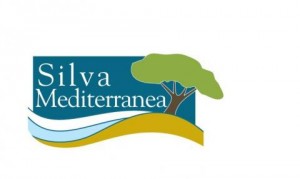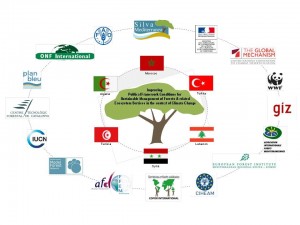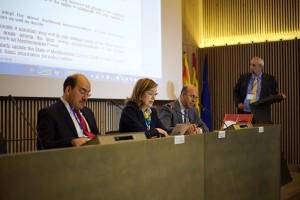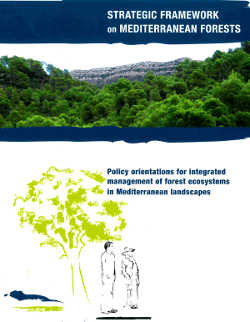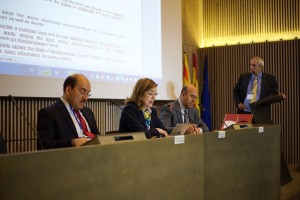Silva Mediterranea Genişletilmiş İcra Kurulu Toplantısı
8 Nisan 2016 Cuma günü “Silva Mediterranea Genişletilmiş İcra Kurulu” toplantısı yapılacak. (6th meeting of the Enlarged Executive Committee of Silva Mediterranea)
http://www.fao.org/forestry/silva-mediterranea/88944/en/
Bununla ilgili davetiye ve gündem aşağıda takdim edilmiştir.
Davetiye:Belen, Ismail
Gündem:ToRs-meeting-executive-committee
Ana konu Silva Mediterrenea çalışma gruplarının değerlendirilmesi.
8 tane Çalışma Grubu var. http://www.fao.org/forestry/silva-mediterranea/88915/en/
Türkiye bunlardan “Desertification and Restoration of Mediterranean drylands” http://www.fao.org/forestry/silva-mediterranea/90989/en/ çalışma grubunun koordinatörlüğünü yapıyor.
Bakanlıktan FAO’ ya gönderilen resmi yazıya göre ÇEM Genel Müdürlüğü Daire Başkanı Özlem Yavuz Koordinatör, TUBİTAK’tan Hande Bilir ise Danışman olarak görevlendirilmiş. Sevilay Özçelik ve Bahar Yalçın ise Sekreteryada görev alacaklar.
Arkadaşlarımıza kolaylıklar diliyorum.
Silva Mediterranea çalışma grupları 2002 öncesinde “Araştırma Network” leri olarak faal durumda idi. 2002 yılında “Çalışma Grupları” haline getirildi.
2016 Mart ayı itibar ile 8 adet çalışma grubu var. http://www.fao.org/forestry/silva-mediterranea/88915/en/
Bunlar:
- ÇG 1: Orman Yangınları. İspanya tarafından koordine ediliyor. Geçmişi 1987 yılına dayanıyor. http://www.fao.org/forestry/silva-mediterranea/88924/en/
- ÇG2: Mantar Meşesi ve Odun Dışı Orman Ürünleri. Portekiz tarafından koordine ediliyor. 1992 yılında kurulan mantar meşesinin silvikültürü araştırma grubunun devamı. 2012 yılında Antalya’da yapılan Silva Mediterrenea 21. Oturumunda son şeklini aldı.http://www.fao.org/forestry/silva-mediterranea/88925/en/
- ÇG3: Orman İdaresi ve Sürdürülebilir Kalkınma. Fransa tarafından koordine ediliyor. 2002 yılında kuruldu. http://www.fao.org/forestry/silva-mediterranea/88926/en/
- ÇG4: Orman Genetik Kaynakları. Koordinatör İtalya. 1987 yılında kurulan “ağaçlandırma çalışmalarında kullanılacak iğne yapraklı türlerin tohumlarının seçilmesi” çalışma grubunun devamı olarak görev yapıyor. 2008 yılında son şeklini aldı.
- ÇG5: Ormanlar ve İklim Değişikliği. Fas ve İtalya tarafından koordine ediliyor. 2008 yılında kuruldu.
- ÇG6: Sürdürülebilir Finansal Mekanizmalar. 2008 yılında kuruldu. http://www.fao.org/forestry/silva-mediterranea/88928/en/
- ÇG7: Kent ve Yarı Kent Ormancılığı. 2012 yılında Türkiye’ nin teklifi üzerine kuruldu. Ancak sonradan süreçten çekildik ve İtalya tarafından koordine edilmeye başlandı. http://www.fao.org/forestry/silva-mediterranea/88929/en/
- ÇG8: Çölleşme ve Akdeniz Kurak Alanlarının Restorasyonu. 2012 yılında Türkiye’ nin teklifi üzerine kuruldu. Koordinatörlüğünü Türkiye yapıyor. http://www.fao.org/forestry/silva-mediterranea/90989/en/
Daha önce de değindiğim gibi ÇEM Genel Müdürlüğü Daire Başkanı Özlem Yavuz Koordinatör, TUBİTAK’tan Hande Bilir ise Danışman olarak görevlendirilmiş. Sevilay Özçelik ve Bahar Yalçın ise Sekreteryada görev alacaklar.
Her çalışma grubunun “İş Planı” var. Bunlara Çalışma Gruplarının linklerinden uluşmak mümkün.
Çölleşme ve Akdeniz Kurak Alanlarının Restorasyonu Çalışma Grubunun İş Planı ilk defa bu toplantı esnasında sunulacak. Arkadaşlarımıza ciddi sorumluluk düşüyor.
Bu iş planının hazırlanmasında şunlardan istifade edilebileceğini düşünüyorum.
- FAO tarafından kurulmuş bulunan “The Forest and Landscape Restoration Mechanism (FLRM)” http://www.fao.org/forestry/flrm/en/ Bu web sayfasını gerçekten incelemek lazım.
- FAO nun düzenli olarak hazırladığı Uluslararası Ormancılık Dergisinin (Unasylva) 2015 yılı Aralık ayında yayınlanan 245 sayısı http://www.fao.org/3/a-i5212e.pdf “Forest and Landscape Restorasyonu” na ayrılmış. Sayfa 37 de, FAO, Orman ve Su İşleri Bakanlığı ve TIKA nın hazırlanma süresince çok büyük destek verdiği “Restoration of degraded forests and landscapes in drylands: guidelines and way forward” küresel rehberin özeti var. Rehberin tam halini http://www.fao.org/3/a-i5036e.pdf linkinden almak mümkün.
- Ayrıca UNCCD COP12′ yi takiben Ülkemiz tarafından geliştirilen Ankara Girişimi ve LDN süreci önemli.
- Son olarak 2017 yılında Fas’ ta düzenlenecek olan “V. Akdeniz Orman Haftasının” teması ” Akdeniz Peyzajının ve Ormanlarının Restorasyonu ” The theme of the V MFW will be: “the restoration of forests and Mediterranean landscapes”. Bununla ilgili olarak 30-31 Mart 2016 tarihlerinde Fas’ ta bir toplantı var. Keşke buraya da katılım sağlanabilse. (1st meeting of the Organizing Committee of the V MFW FAO, HCEFLCD, 30 March 2016 – 31 March 2016, Morocco, Rabat, HCEFLCD) http://foris.fao.org/meetings/download/_2016/_1st_meeting_of_the_organizing_committee_of_the_v_/misc_documents/co1_tors_en.pdf
8 Nisan’da yapılacak toplantıya Silva Mediterranea Başkanı olarak Türkiye’ nin, Fransa ve Fas temsilcilerinin, Silva Mediterranea Sekretaryasının ve bu sekiz adet çalışma grubunun temsilcilerinin, koordinatörlerinin katılması bekleniyor.
Görünen o ki, Türkiye’den Özlem Yavuz, Hande Bilir ve Bahar Yalçın bu toplantıya katılacaklar.
18 Mart 2015 tarihinde Barcelona’da yapılan “Silva Mediterranea Toplantısı”nda çalışma grupları ile ilgili önemli kararlar alındı.
Geçmişe ait bilgi için:
http://www.gonder.org.tr/?p=1679
http://www.gonder.org.tr/?p=3499
Konunun Geçmişi (burdan aşağıya şimdilik İngilizce devam edeceğim:)
Background
The 2013 evaluation of Silva Mediterranea evidenced that the working groups of Silva Mediterranea had different functioning modalities, with different scopes and different implications of FAO. Several decisions taken by the Committee Silva Mediterranea at its extraordinary session in Barcelona on 18 March 2015, on the basis of the recommendations of this evaluation, dealt with working groups:
http://www.fao.org/forestry/43060-0a587ab7db556f9287aca6e2dcda8aadf.pdf
- 1. To ensure the supervision of the connection between the Committee’s future strategy and the subsidiary bodies’ activities (thematic groups and task forces);
- 2. To foresee the establishment of two new types of subsidiary bodies: (1) interface thematic groups and (2) Task Forces;
- 3. To promote targeted themes for which FAO Forestry Department has experts and at the very least to continue its work around forest fire issues, biodiversity and forest genetic resources, non-wood forest products (NWFP), urban and periurban forests (UPF) and the fight against desertification/restoration of degraded lands and forests;
- 4. To ensure a transition from the existing working groups to the new types of groups;
- 5. To identify the coordinators, who are representatives of member states, based on motivation criteria and limit their mandate’s duration;
- 6. To formally add contribution of FAO Officers in the description of their respective position;
- 7. To promote the FAO Officers’ mobilisation for the benefit of the Committee’s activities.
The first of these decisions refers to the establishment of a specific strategy for Silva Mediterranea, based on the Strategic Framework on Mediterranean Forests (SFMF). Members of the Silva mediterranea originally expressed their interest in the SFMF on the occasion of the 2nd Mediterranean Forest Week in Avignon (April 2011). The SFMF was presented at the 3rd Mediterranean Forest Week in Tlemcen and endorsed by the high-level segment of this conference under the Tlemcen Declaration. Members of Silva mediterranea confirmed their interest for the SFMF during the extraordinary session of the Committee held in Barcelona on 18 March 2015 with two decisions taken on the basis of the recommendations of the evaluation of Silva Mediterranea:
- 8. To elaborate a common view and its own strategy based on the identification of priority areas among the lines and/or recommendations of the Strategic Framework on Mediterranean Forest;
- 9. To elaborate an action programme based on this new strategy of Silva Mediterranea.
Objective
The meeting of the Executive Committee of Silva Mediterranea will aim at initiating the definition of a specific strategy for Silva Mediterranea based on the SFMF and at ensuring the consistency between the activities of the working groups of Silva Mediterranea and this strategy. Synergies between working groups will be sought, e.g. through the identification of possible joint actions for project proposals, or by the establishment of a common communication line regarding publications. The meeting will also aim at reinforcing the mobilisation of FAO Officers for the benefit of the activities of the working groups.
Expected results
- The work plans of the working groups for 2016-2017 are clarified, updated and shared among groups.
- The main axes for a specific Silva Mediterranea strategy are identified and a roadmap towards the definition of this strategy is established.
- Synergies and interactions among working groups are developed.
Participants
The Enlarged Executive Committee of Silva Mediterranea is composed of the Bureau, of the coordinators of the working groups of Silva Mediterranea, and of representatives of France and Morocco. The participation of FAO Officers that contribute to the activities of the working groups, and more generally of experts that take part in the activities of the working groups, will strongly contribute to the success of this meeting.
Provisional agenda
- 1. Welcome address, introduction of participants, meeting agenda, presentation of the objectives and expected outcomes
- 2. Presentation of the activities and 2016-2017 work plan of the Working group on forest fires (coordinator of WG1)
- 3. Presentation of the activities and 2016-2017 work plan of the Working group on cork oak and non-timber forest products (coordinator of WG2)
- 4. Presentation of the activities and 2016-2017 work plan of the Working group on forest management and sustainable development (coordinator of WG3)
- 5. Presentation of the activities and 2016-2017 work plan of the Working group on forest genetic resources (coordinator of WG4) 4
- 6. Presentation of the activities and 2016-2017 work plan of the Working group on forests and climate change (coordinator of WG5)
- 7. Presentation of the activities and 2016-2017 work plan of the Working group on sustainable financing mechanisms (coordinator of WG6)
- 8. Presentation of the activities and 2016-2017 work plan of the Working group on urban and peri-urban forestry (coordinator of WG7)
- 9. Presentation of the activities and 2016-2017 work plan of the Working group on desertification and restoration in Mediterranean drylands (coordinator of WG8)
- 10. Building a specific strategy for Silva Mediterranea
- 11. Developing synergies and interactions among working groups
Bu arada 18 Mart 2015 tarihinde yapılan Silva Mediterranea toplantısında alınan kararlara bir bakmakta fayda var. Esas itibari ile 8 Nisan 2016 tarihindeki toplantı 18 Mart 2015 tarihli toplantının devamı niteliğinde.
I. Context of the extraordinary session
The Extraordinary session of the of the Committee on Mediterranean Forestry Questions-Silva Mediterranea took place on March 18, 2015 in Barcelona, during the IV Mediterranean Forest Week (17-20 March 2015).
The two main items of the agenda were:
- the discussion of the Evaluation of the Committee on Mediterranean Forestry Questions-Silva Mediterranea based on the Management Response prepared by the Forestry Department of FAO ;
- the booth on Mediterranean forests to be organized with all interested Mediterranean partners at the XIV World Forestry Congress (Durban, 7-11 September 2015).
II. Decisions on the Evaluation of the Committee on Mediterranean Forestry Questions-Silva Mediterranea
During the Extraordinary session of the Committee on Mediterranean Forestry Questions-Silva Mediterranea, the Secretariat presented to Member States the Management Response prepared by the Forestry Department.
Based on this Management Response and the discussion with Member States of the multiple recommendations proposed by the Independent Panel in charge of the evaluation of the Committee on Mediterranean Forestry Questions-Silva Mediterranea the list of all the approved recommendations was established and the following decisions have been taken by the Committee:
1. Decisions towards a renewed framework
- To review the mandate of the Committee in order to focus itself again on (1) the dialog in terms of forest policy and (2) the identification and follow up of regional cooperation priorities;
- To reflect upon the composition of Silva Mediterranea after a systematic sum up of the situation of the current Member States;
- To elaborate a common view and its own strategy based on the identification of priority areas among the lines and/or recommendations of the Strategic Framework on Mediterranean Forest; http://www.fao.org/forestry/silva-mediterranea/89602/en/
- To elaborate an action programme based on this new strategy of Silva Mediterranea;
- To aim at a more continuous and sustained participation of the high level decision makers of the region in the Committee’s sessions;
- To aim at an effective articulation of the Committee with the bodies and forums directly or indirectly engaged in forestry questions;
- To follow the evolution of the negotiations of a legally binding agreement on forests in Europe and UNFCCC, UNCDD, UNCBD negotiations related to forests;
- To regularly update the State of Mediterranean Forests (SoMF); http://www.gonder.org.tr/?p=4844
- To grant added visibility to the Silva Mediterranea Committee during the sessions of the Committee on Forestry (COFO) and contribute to a greater visibility and consideration of Mediterranean forests issues in the agenda of international bodies and forums (CPF, UNCBD, UNFCCC, UNCCD, UNFF, WFC);
- To regularly raise awareness of FAO regional offices and regional forestry Commissions within the countries on the issues addressed by the Silva Mediterranea Committee;
- To implement a transversal thinking on the status and role of the observers within statutory and subsidiary bodies and to have the Committee beneficiate from this thinking.
2. Decisions for more readable links with the partners:
- To intensify bidirectional exchanges (needs and feedbacks/outputs) with the working area of research, training, capacity-building and information production;
- To promote the participation of key stakeholders in these different working areas as observers of the Committee’s sessions;
- To contribute to the organization of the Mediterranean Forest Week regularly as an open forum for different sectors, stakeholders and sensibilities;
- To request the Committee’s Secretariat to ensure the coordination of the organization of the Mediterranean Forest Weeks;
- To reanalyse its communication (Website, Newsletter, etc.) so that a clear distinction is made between its own contributions and those of each partner.
- To establish a light coordination platform between the main intergovernmental organizations interested in the Mediterranean forests including CIHEAM, Centre for Mediterranean Integration (CMI), EFIMED, FAO, Plan Bleu, Union for the Mediterranean (UfM), (rotating secretariat, equal footing etc.); (Coordination meeting between CIHEAM, CMI, EFIMED, FAO, Plan Bleu, UfM
FAO, 29 January 2016, Concept note for the forestry coordination meeting (English), Minutes of the meeting (English)
- To request the Committee’s Secretariat to ensure the Chair of this new regional platform.
3. Decisions for a smoother internal functioning
- To direct the Committees Secretariat’s activities towards the reinforcement of the link between the members states and the internal dynamics and towards effective and continuous reactivation of the national focal points’ network; (Bütün üye ülkelere bir mektup yazılabilir- )
- To define the respective roles of the chair, secretary, members of the Bureau and of the Executive Committee by drafting terms of reference and to update the internal rules;
- To reinstate the biennial Committee’s sessions;
- To organise the Committee’s sessions every two years on the occasion of Mediterranean Forest Weeks;
- To reconsider the existence of the Enlarged Executive Committee;
- To ensure a full time Secretariat for the Committee with the support of seconded experts funded by Member States within the Forestry Department;
- To carry out and animate a transversal and internal reflection on the functioning and animation of the national focal points’ networks (capitalize on experiences within the Forestry Department like FRA, Mountain Partnership, UNREDD…and outside the Forestry Department in order to identify good practices).
4. Decisions on interface subsidiary bodies
- To ensure the supervision of the connection between the Committee’s future strategy and the subsidiary bodies’ activities (thematic groups and task forces);
- To foresee the establishment of two new types of subsidiary bodies: (1) interface thematic groups and (2) Task Forces;
- To promote targeted themes for which FAO Forestry Department has experts and at the very least to continue its work around forest fire issues, biodiversity and forest genetic resources, non-wood forest products (NWFP), urban and periurban forests (UPF) and the fight against desertification/restoration of degraded lands and forests;
- To ensure a transition from the existing working groups to the new types of groups;
- To identify the coordinators, who are representatives of member states, based on motivation criteria and limit their mandate’s duration;
- To formally add contribution of FAO Officers in the description of their respective position;
- To promote the FAO Officers’ mobilisation for the benefit of the Committee’s activities
- To ensure internal coordination between the FAO Officers connected to the Committee.
5. Decisions on better structured voluntary contributions
- To explore new regional or global financing opportunities;
- To encourage the mobilization of voluntary contributions from Member States.
- To ensure a long term, efficient and dynamic functioning of the national focal point; (via Ministry of Foreign Affairs and FAO’s Regional/Country Offices)
- To ensure that a relay is established at national level between the Committee’s national focal points and the stakeholders and sectors involved in the management of the Mediterranean forests;
- To supply representatives who are engaged in the Committee’s activities with the necessary resources and support
The above-mentioned decisions have been taken into account during the High-Level Session of Director in charge of Forests organized on March 20, 2015 and several key decisions have been formally endorsed by the High Level Session (See annex 2 : Barcelona Declaration).
Geleceğe GÖNDERiler
Geleceğin, kişilerin hayalleriyle ve yaptıklarıyla şekilleneceğinin farkındayız. Herhangi bir şeyi daha iyiye götüreceğine inandığınız bir düşünceniz mi var? Herhangi bir konuda yeni bir fikriniz mi var? “Buldum” dediğiniz bir şey mi icat ettiniz? Heyecanınızı yürekten paylaşıyoruz. “Geleceğe GÖNDERi”lerinizi bizimle paylaşın, destek olalım! Lütfen görüş ve önerilerinizi gonder.carfu@gmail.com eposta adresi ile bizimle paylaşın. Köşe Yazıları bölümünde yazı […]

